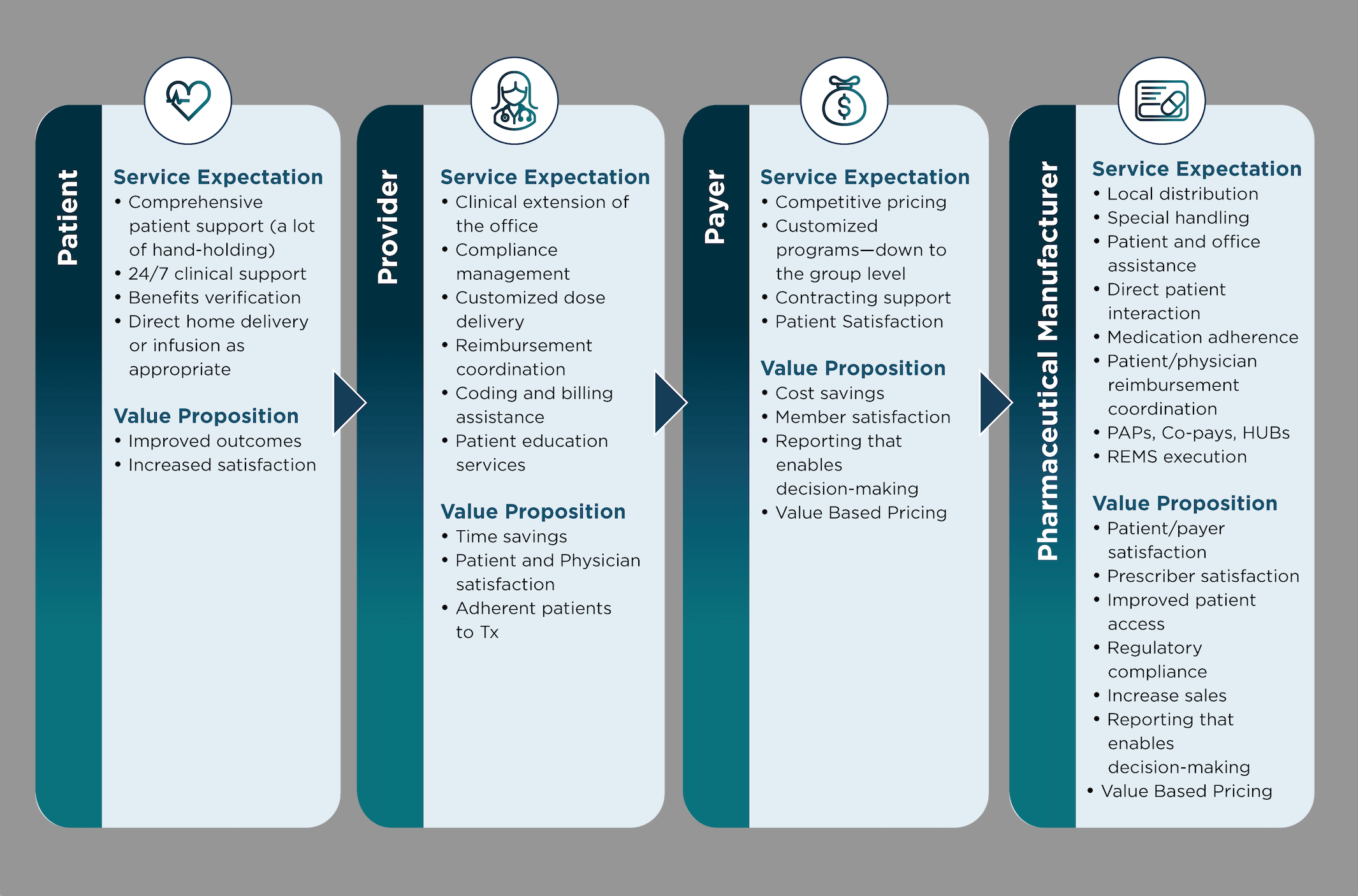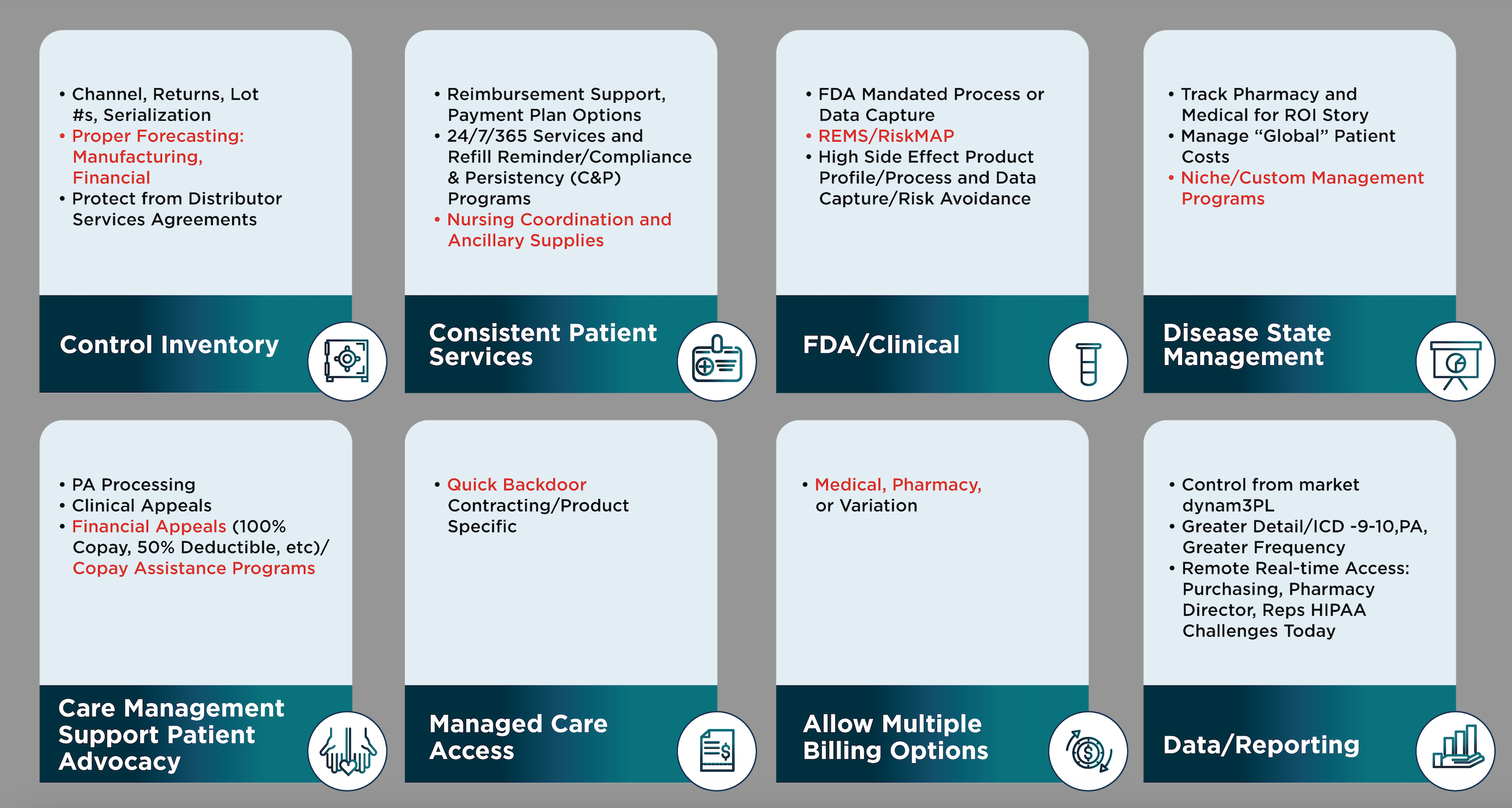Article
Developing a Limited Distribution Plan for Oral Oncology Products
The portfolio of oral oncology products has evolved over the past few years and so has the traditional model of distribution.
Distribution strategy is one of several key decisions that a manufacturer must make early in the process when launching a new oral oncology product. As the market has shifted from traditional community-based products to specialty medications, expanded solutions to better serve these products have evolved.
High-touch, oral oncology products require distribution solutions that are targeted toward maximizing patient outcomes. Limited distribution through a carefully selected specialty pharmacy network offers a greater level of patient care but also brings more complexity and the need for greater understanding to identify the right solution.
Why Select a Limited Specialty Pharmacy Distribution Model for Your Product?
Specialty pharmaceuticals are defined as products that treat chronic, high-cost, or rare diseases. They can be injectable, infusible, oral, or inhaled medications, and they tend to be more complex to maintain, administer, and monitor than traditional drugs.
Therefore, they require closer supervision in their production and closer monitoring of a patient’s overall therapy. Key characteristics include:
- Frequent dosage adjustments
- Potentially more severe adverse effects (AEs) than traditional drugs
- Special storage, handling, and/or administration
- Narrow therapeutic range
- Periodic laboratory or diagnostic testing
- Higher annual costs than traditional products ($10,000-$100,000)
- Target small numbers of patients (5000-100,000)
- Patient registration
- Patient training and clinical call center
- Compliance management
- Clinical data reporting and analysis
The Value Proposition for All Stakeholders With Limited Specialty Pharmacy Distribution
To satisfy the needs of managing the supply chain for oral oncology specialty products, it is important to consider them in unison across the spectrum on stakeholders, including the patient, provider, payer, and pharma manufacturer as illustrated below in Figure 1.

Limited Distribution Through a Specialty Pharmacy Network
Specialty pharmacy is defined as the service created to manage the handling and service requirements of specialty pharmaceuticals, including dispensing, distribution, reimbursement, case management, and other services specific to patients with rare and/or chronic diseases. Oral oncology products have their own set of complexity, such as titration and dosing based on several clinical factors.
Reimbursement for oral oncology products can be extremely challenging, due to product costs and duration of therapy. Specialty pharmacies participating in a limited distribution network frequently take on the assignment of benefits or the burden of obtaining reimbursement by billing insurance directly.
Patients benefit by eliminating the claims process and the associated risk of non-reimbursement, which is a significant factor because so many of these products have complex reimbursement procedures and high product costs. Additionally, specialty pharmacies will verify insurance coverage prior to shipping products, which eliminates potential challenges down the road.
With the high-touch care that specialty pharmacies provide, patient hotlines are available for reimbursement-related questions and are staffed by oncology product-area experts to ensure better customer support. These experts help patients navigate complicated insurance policies and procedures, and focus on any plan-specific limitations and requirements, including co-pays, deductibles, coinsurance, lifetime spending caps, prior approval requirements, and pre-existing condition clauses.
Because coverage is often denied, the specialty pharmacy may file an appeal on behalf of the patient. If the appeal is unsuccessful, the pharmacy can assist in finding other means to obtain access to their medications via patient assistance programs or other methods of payment.
Clinically-Focused Care for Oral Oncology Products
Most specialty pharmacies provide around-the-clock clinical support hotlines, which may include staffing by a board-certified oncology pharmacist and oncology nurses who are highly trained on oncology products and are able to answer questions on a wide range of clinical issues. As we have defined oral oncology products and the nature of their associated diseases and treatments, it is critical that patients have access to information about administration, dosing, and AEs, as well as other reactions that are often dose-related.
Cost-effective pharmacotherapy and disease-state management offer targeted interventions that improve patient education and health outcomes, thereby reducing the total cost of care on an outbound basis. Typically, patients are educated on the proper administration of oral oncology products through various communication channels, including video and print.
Many oral oncology manufacturers invest in patient-specific websites designed to assist patients and in partnership with the specialty pharmacy, patients are guided through their therapy. Further, many oral oncology products require either up or down titration depending on a number of factors, including AEs.
Dose titration is managed through the assistance of both BCOPs and oncology nurses who stay in constant contact with the patient, working closely with them and their oncologist to achieve the right dose for maximum efficacy and patient adherence. Study results show that poor adherence is frequently the result of difficult administration procedures and challenging AEs that accompany some products.
Specialty pharmacy teams are specifically trained on each of the oral oncology products they dispense, which is a key driver in why a manufacturer is compelled to limit which specialty pharmacies are qualified to manage the distribution of their product. Highly trained professionals providing consistent care is instrumental in providing the best outcome for the patient.
One cornerstone of oncology specialty pharmacy is compliance—or following a treatment regimen as prescribed—and may include factors such as the timing and dosing of the oral oncology product. Persistence is defined by how well the patient remains on the oral oncology product over time.
Factors that contribute to poor compliance and persistence rates among patients who use oral oncology products include cost, AEs, and comorbidities. In turn, poor compliance and persistence can lead to diminished efficacy and outcomes that cause higher-cost inpatient treatments.
By far, the top reason for choosing a specialty pharmacy is that their expertise in managing oncology patients to take their prescribed therapies properly and consistently. These focused services, ideally offered through a limited distribution model that may include a specialty pharmacy, are not typically present in traditional distribution (Figure 2).

Boiling Down Why Limited Distribution Makes Sense for Oral Oncology Products
Limited distribution is here to stay for oral oncology products as we see more approvals for this category—they are here and are the future. Add in critical factors such as complex dosing, the management of AEs, and specialized handling—making specialty pharmacy the best solution.
Ensuring the provider or patient/caregiver have been supplied with all essentials in one order is the new norm. This may include having the necessary training to assist patients with titrating the correct dose, often based on AE profiles or weight or severity of their cancer. Limited distribution often is established to include inventory management programs, utilizing just-in-time delivery processes that eliminate the need to maintain a large inventory, thereby ensuring the stability and availability of the product on hand both for the specialty pharmacy or dispensing physician.
The portfolio of oral oncology products has evolved over the past few years and so has the traditional model of distribution. It is no longer feasible for a manufacturer to just put their product into the supply chain and hope it will make downstream together with all the demands it requires.
Manufacturers have evolved into more strategic and targeted distribution strategies for the benefit of assuring that all stakeholders can maximize the value of their oral oncology products and produce better patient outcomes.
About the Author
Dan Steiber, RPh, focuses on the commercialization and start-up of emerging pharma organizations, new product launch strategies, third party logistics - supply chain optimization management, hub, trade development and marketing, formulary and contracting initiatives, and other business development efforts. With over 40 years of experience, Mr. Steiber has served as executive vice president for the AmerisourceBergen Specialty Group and general manager of ICS, a premier third-party logistics organization with $400MM-plus in revenues and 250-plus associates in his chain of command. His commercial expertise stems from launching over 100 organizations and hundreds of prescription and specialty products. Serving as senior vice president for Bergen Brunswig and later AmerisourceBergen, he had responsibility for all manufacturer relationships and retail marketing. Steiber understands pharma sales, having "carried a bag" for Eli Lilly, right out of pharmacy school.






